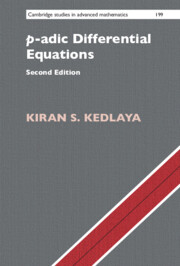Book contents
- Frontmatter
- Contents
- Preface
- Acknowledgments
- 0 Introductory remarks
- Part I Tools of p-adic Analysis
- 1 Norms on algebraic structures
- 2 Newton polygons
- 3 Ramification theory
- 4 Matrix analysis
- Part II Differential Algebra
- Part III p-adic Differential Equations on Discs and Annuli
- Part IV Difference Algebra and Frobenius Modules
- Part V Frobenius Structures
- Part VI The p-adic local monodromy theorem
- Part VII Global theory
- Appendix A Picard–Fuchs modules
- Appendix B Rigid cohomology
- Appendix C p-adic Hodge theory
- References
- Index of notation
- Subject index
2 - Newton polygons
from Part I - Tools of p-adic Analysis
Published online by Cambridge University Press: 06 August 2022
- Frontmatter
- Contents
- Preface
- Acknowledgments
- 0 Introductory remarks
- Part I Tools of p-adic Analysis
- 1 Norms on algebraic structures
- 2 Newton polygons
- 3 Ramification theory
- 4 Matrix analysis
- Part II Differential Algebra
- Part III p-adic Differential Equations on Discs and Annuli
- Part IV Difference Algebra and Frobenius Modules
- Part V Frobenius Structures
- Part VI The p-adic local monodromy theorem
- Part VII Global theory
- Appendix A Picard–Fuchs modules
- Appendix B Rigid cohomology
- Appendix C p-adic Hodge theory
- References
- Index of notation
- Subject index
Summary
In this chapter, we recall the traditional theory of Newton polygons for polynomials over a nonarchimedean field. In the process, we introduce a general framework which will allow us to consider Newton polygons in a wider range of circumstances; this framework is based on a version of Hensel’s lemma that applies in not necessarily commutative rings. As a first application, we fill in a few missing proofs from Chapter 1.
- Type
- Chapter
- Information
- p-adic Differential Equations , pp. 36 - 45Publisher: Cambridge University PressPrint publication year: 2022

